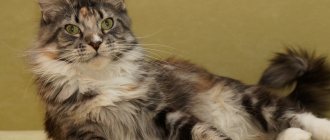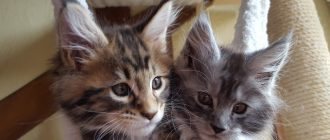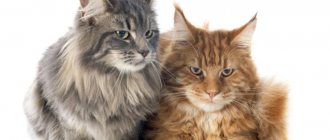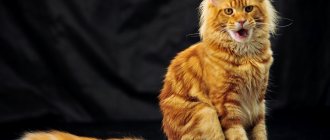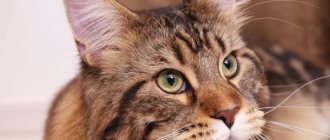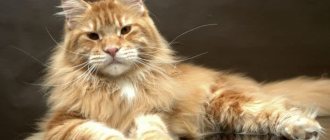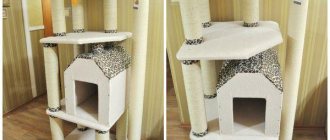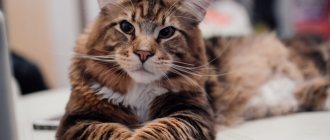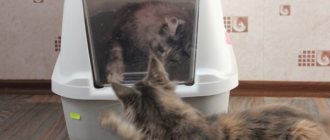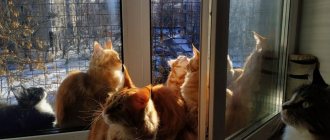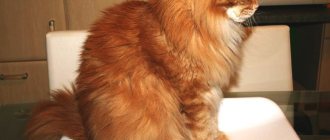How often to bathe Maine Coons
Dust, accumulating static electricity, dry air in city apartments - all this does not have the best effect on the coat. Therefore, regular care and washing are necessary for cats, even if they do not belong to the show class . Typically, bathing is indicated for pets in cases of heavy soiling, contact with toxic substances on the fur, or infection with ectoparasites.
In addition to these cases, it is recommended to wash Maine Coons once every three to four months. This procedure is not only hygienic, but also cosmetic in nature, it gives the wool a special shine and prevents it from matting.
Another circumstance affects the frequency of washing Maine Coons. In mature, uncastrated cats (as an exception - in cats), the sebaceous glands located at the base of the tail secrete a fat-like substance. When it settles on the fur, it glues the hairs in this area; sticky layers form on the adjacent areas of the back. A luxurious tail that turns into an “icicle” is a signal that it’s time to bathe the animal.
Important! A “greasy tail” not only looks unsightly, but can also lead to serious medical problems if the fur and skin are not promptly cleaned of fatty secretions.
Return to content
General rules
Caring for and maintaining a Maine Coon is not a cheap pleasure. An animal requires high-quality, nutritious nutrition, and during the period of active growth and development, the pet must be fed intensively, otherwise the pet’s health may suffer.
Cats of this variety have a good-natured, easy-going character; Maine Coons love children very much and almost never conflict with other pets. It is better when the kitten lives in a country house, where he can actively move, climb trees, develop muscles and skeleton. The cat loves to swim, bathe and dive, so you can equip a small pool for him in the yard or install a bathtub with water. Washing your pet with shampoo is often prohibited. If the cat lives in an apartment, it is important to regularly take him for a walk, first putting on a leash. There are often no difficulties in raising this breed; the main thing is to explain to the pet the important rules of behavior in a timely manner and to encourage the kitten if it has done everything correctly. In addition, you should choose a suitable name for your pet, which will reflect the individual characteristics of character and behavior.
Preparation for water procedures
At the preliminary stage, you need to prepare everything you need to wash your Maine Coon. You will need:
- an anti-slip mat or towel to place on the bottom of the bathtub;
- harness with a carabiner on a suction cup to secure the animal during the procedure;
- rubber pad for combing wool;
- small soft brush;
- brush with medium-hard bristles;
- 2 large terry towels;
- all the necessary set of zoocosmetics for washing.
Separately, it should be said about skin and coat care products that are used to wash Maine Coons.
- Shampoo and conditioner for long-haired cats is sufficient as part of normal hygiene procedures.
- To prepare for an exhibition or bathe an animal with a noticeably greasy tail, groomers and veterinarians recommend additionally using degreasing paste and coloring, texturing, and conditioning compounds.
- For white Maine Coons, you can choose special products to eliminate the yellow tint and lighten the coat.
- For baby cubs, hypoallergenic shampoos of the “tearless” category are intended, the composition of which, in addition, takes into account the characteristics of the soft texture of the kitten’s fur.
Important! The pH balance of human and animal skin is different. Therefore, you should not wash your cat with shampoos intended for humans. The result of using such detergents for Maine Coon will be dry, irritated skin, dandruff, poorly cleaned and dull coat.
Before washing, comb or cut out matted hair and tangles in problem areas of the pet - the lower neck, armpits, behind the ears, on the stomach and panties. Also, if necessary, trim the claws . Only after all breakable and potentially dangerous objects have been removed from the pet’s reach in the bathroom, do they begin bathing.
Return to content
How to care for a cat?
Ears and eyes
If wax accumulates in the ears, you should carefully remove it with cotton swabs or pads.
If Maine Coon kittens do not have health problems, their ears inside are clean, pink, without foreign inclusions or plaque. However, it is important to regularly inspect the ears and remove wax with a cotton pad as necessary. It is not difficult to accustom your cat to this hygiene procedure. When cleaning the ears, you need to play with the cat. Then the animal will have pleasant associations with the procedure and will be happy to allow the accumulated dirt to be removed from the folds.
If the cat’s eyes do not fester, it is enough to wipe the inner and outer corners of the eyelids several times a week with a cotton swab soaked in a bactericidal herbal decoction, removing mucus and stuck together lumps of dirt. If the mucous membrane is inflamed, the eyes are watery, or brown discharge appears from the eyes, you cannot do without drug treatment. Once the diagnosis is made, the veterinarian will prescribe anti-inflammatory medications. First, the drug is instilled into one eye, then into the second, even if there are no signs of damage in it.
Muzzle, teeth
During the active growth of Maine Coon kittens, special attention should be paid to their teeth. The breed is not prone to dental problems, however, if the animal has any internal problems, this will immediately affect the condition of the teeth. You can immediately notice that not everything is all right with the cat. His jaw may be in an unnatural position, and an abnormal bite will become noticeable. Often such defects become noticeable in the first month of life. To know how to help your cat, you should take him to an appointment with a veterinarian.
Nail trimming
It is necessary to trim your pet's nails with care so as not to touch the sensitive area.
If a cat lives in an apartment, it is important to regularly care for its claws, periodically trimming them with special clippers. You only need to cut off the sharp edges, otherwise you can damage the blood vessel, and next time there will be difficulties and problems with this procedure. When an animal spends a lot of time outside, there is no need to trim its nails, because they wear down naturally.
How to wash a cat?
Bathing for Maine Coon cats is a pleasant experience. The animal is not at all afraid of water; the adult cat swims well and is ready to swim even every day. Water for hygiene procedures should not be too cold or hot, the optimal temperature is 37 degrees. It is recommended to bathe a Maine Coon with shampoo no more than once every 3 months. When washing an animal, it is important to ensure that soapy water does not get into the eyes and ears. Kittens and adult cats should buy a special Maine Coon shampoo. The wet cat is carefully wrapped in a soft towel. Drying wool with a hairdryer is strictly prohibited.
It is unusual and pleasant to watch cats of this breed, especially when they bathe and willingly swim in the bath.
How to comb the fur?
The Maine Coon's coat is thick and long. The breed is not hypoallergenic, so if one of the family members suffers from allergies, then it is worth getting a kitten of a different breed. It is important to brush your pet daily. Special combs for long-haired cats comb the hairs well. This brush is called a furminator. When the animal does not shed, a regular comb will help to comb out dead skin particles, dust and dirt. During the molting period, you cannot do without a special brush. You need to scratch the animal carefully, in the direction of hair growth. After the procedure, it is important not to forget to wash the comb. Proper care of the Maine Coon's coat will provide the coat with a healthy, beautiful shine.
What should the diet be like?
High-quality and nutritious feeding is the key to good health and proper development of your pet. For kittens up to 6 months. requires special care. The basis of feeding at this age is milk, cereals, meat, and vegetables. Meals should be regular, the number of meals is 5-6 r. for a day. If desired, an older animal can be switched to ready-made factory food, however, there are some subtleties here too. Cheap canned food is not suitable for Maine Coons, because they are not able to provide the body with the necessary vitamins. Therefore, it is recommended to give preference to ready-made premium or super premium products. It is recommended to feed at the same time no more than 3 times a day.
Maine Coons' diet should consist of meat products, as they are classified as carnivores.
Often, owners prefer to give Maine Coons natural homemade food. The animal is a carnivore, so the basis of its diet consists of meat products and offal. Fatty, fried, spicy, smoked and sweet foods are strictly contraindicated. The following healthy products diversify the menu:
- fresh or boiled vegetables, such as carrots, beets, cabbage, zucchini, pumpkin;
- hard cheeses;
- quail eggs;
- seafood, such as fish or seaweed;
- cereals: buckwheat, rice, oatmeal;
- fermented milk products - cottage cheese, kefir, yogurt, sour cream, fermented baked milk;
- grass, sprouted grains of oats or wheat.
Upbringing
Adaptation of a Maine Coon to a new home is quick, provided that the owner treats the animal with affection and love. The pet learns to use the litter box without any problems and gets along well with children and other pets. If the cat is naughty, climbs on furniture, curtains, or tears at wallpaper with its claws, you should start raising it. If you catch your pet doing something inappropriate, you must strictly say “no”. It is forbidden to hit a kitten, otherwise it will stop trusting its owner and become wild and unsociable. It is important to walk your cat regularly. If the Maine Coon lives in the city, then a special harness is used during walks. In a private yard, the animal can move around unlimitedly.
Bathing a Maine Coon kitten
How the baby’s first acquaintance with the bath procedure goes will largely determine the animal’s further attitude towards washing. Therefore, all actions should be aimed at making the process the least intimidating.
- You need to bathe a kitten no earlier than two weeks after it arrives in the house: the stress of moving and washing will reinforce each other.
- You don't need a water container that is too large - the bath is perfect for an adult Maine Coon, but it will be uncomfortable for a small one. The best option is a plastic basin with high sides, in which the kitten can stand, firmly resting on its paws. It would be a good idea to place a towel or mat on the bottom of the basin to prevent slipping. The height of the water should be such that it reaches the pet’s neck, completely covering the body. The temperature of the water is also important: the range from 36 to 39 °C is considered comfortable.
- The kitten is placed in a container and a pre-prepared retainer is secured around the neck or held firmly by hand. The fur is gradually moistened (do not use a shower) and then foamed shampoo is successively applied and rubbed into it. You can only wet your head with a sponge to prevent water from flowing into your ears. Since Maine Coon kittens do not yet have the problem of greasy tails, they limit themselves to one-time soaping.
- After washing, the kitten will definitely begin to lick itself. To prevent detergent residue from entering the stomach and causing poisoning, the shampoo must be rinsed off very thoroughly, changing the water in the basin 2-3 times. The procedure is completed by lightly squeezing the wool with a towel, as well as obligatory praise of the baby for courage and bravery.
Important! When washing, you should never be impatient or nervous. Even at a very tender age, Maine Coons perfectly feel and perceive the mood of their owner. Sudden movements and intonations will further increase the kitten’s fear of an unfamiliar environment. Soothing, approving words, confident but gentle movements are the only correct human behavior when bathing a small pet.
For minor stains, an alternative to bathing can be using dry shampoo, but this does not replace a full wash and does not give the kitten any idea about it.
Return to content
Nose and eye care
A healthy animal's eyes and nose are usually clean. But there are exceptions in cats of red and tortoiseshell colors. They may accumulate dirt in the corners of their eyes and nostrils. This does not always indicate any disease (if the discharge is not heavy). In this case, it is necessary to carefully remove the accumulations with a regular cotton pad soaked in warm water.
You can do a rinse with chamomile. To do this, you need to take 1 teaspoon of dried flowers, pour 100 ml of boiling water over them, and then let it brew. The infusion can be used only when it has completely cooled down. Brushing should be done slowly, from the outer corner of the eye to the nose.
If your cat has excessive discharge from the nose and eyes, it is better to consult a veterinarian, as this could be rhinotracheitis, chlamydia and other diseases. In this case, ordinary washing cannot eliminate the disease; more serious treatment will be required.
Important! Never use regular tea to clean your eyes. It dries out the mucous membranes and most often only makes the situation worse. Especially if the brew contains the addition of lemon, bergamot, fruit and other things.
Bathing an adult cat
Washing an adult Maine Coon takes longer and is more labor-intensive.
- First of all, the animal is seated in the bathtub and secured with a harness.
- The preliminary step should always be basic degreasing: a special paste is applied to the dry fur of the most greasy areas - tail, back, collar and behind the ears - with a brush and left for 5 to 8 minutes (the exact time is specified in the instructions for the product).
Important ! For deep cleansing in the most problematic area, the upper part of the tail, the hair should be worked through to the skin.
- Then wash off the paste with warm water, not forgetting to fold the animal’s ears so that water does not get into them.
- A small amount of degreasing shampoo is first rubbed in the palms of the hands and applied with massage movements to the coat along the hair growth, paying special attention to the tail. The paws are washed with a brush, the body with a pad. This allows you to remove dead hair at the same time as washing. If the animal is washed regularly, it is enough to apply degreasing shampoo once, after which it is washed off with running water.
- To restore the structure of the coat and saturate each hair with keratin, use a texturizing shampoo, rubbing it in as thoroughly as a degreasing shampoo, and then rinse it off until the flowing water becomes clear.
- Coloring is done only when necessary - it is more of a decorative measure than a hygienic one. Experiments with color are usually carried out on the eve of exhibitions and for Maine Coons of a certain color.
- The wash is completed with conditioning, the purpose of which is to return natural fatty lubrication to the hair, close the hair cuticle, and protect it from external adverse influences. Conditioner with an added drop of liquid silk is applied to areas with top coat hair: this gives the coat an amazing shine. The remaining areas can be treated with the product without additive.
Carry out the final rinse thoroughly, and if the wool creaks under your hand, it means it has been washed well.
Return to content
How to bathe short-haired cats
For short-haired breeds with dark colors, washing can be replaced with dry brushing. It is carried out using special powders or bran heated to 40°C. The product is actively rubbed into the coat, lightly massaged and then combed out with a comb. Dry cleaning, like bathing, is more convenient to do together.
Water procedures are part of a set of general hygiene measures, thanks to which cats maintain not only their external beauty, but also avoid many problems with health and well-being.
Video on the topic:
VN:F [1.9.22_1171]
wait a second...
Rating: 0.0/ 10 (0 votes cast)
Drying wool after bathing
The process of drying Maine Coon wool also has its own characteristics: it is probably impossible to do this without an assistant.
- The cat's entire body is wrapped in the first towel and the fur is blotted with light squeezing movements.
- Then they take another towel and cover the animal with it on top.
- One front corner is pulled under the belly, the second one covers the front legs. Both corners are connected, tied behind the cat’s back and waited for about 10 minutes so that excess moisture is completely absorbed into the fabric.
- Remove the towel and comb the wool everywhere, at the same time unraveling and removing tangles if they formed during washing.
Then they use a hairdryer if the cat is accustomed to it.
- The main drying begins with the panties: the wool is pressed against the body and the air flow directed against the wool gradually works through individual strands.
- When drying the body, it is better to lay the animal on its side on a horizontal surface. The helper grabs both pairs of paws above the hocks and holds the cat. The groomer, running a fine comb against the fur, uses a hairdryer in turn to work all areas of the body, the outer and inner surfaces of the paws.
- The tail is dried using a hairdryer and a slicker, moving in a spiral against the hair from the base to the end.
- Lastly, the collar and tummy are treated.
If the wool is well dried, the comb passes through it easily . A cat, not accustomed to a hairdryer since childhood, has to be dried in the same way, constantly holding the animal, breaking and combing the damp strands of fur.
A loving owner who spares no time and effort in washing the Maine Coon will be rewarded with a shiny, smooth, well-groomed, silky coat of the pet.
Return to content
Nail care
Outdoor cats climb trees and walk a lot on hard, uneven surfaces. At this time, the claws are sharpened naturally. For domestic cats, the situation is different, so they need help in this sensitive matter.
It would be useful to install a scratching post in the house, since while the Maine Coon sharpens its claws on it, excess rough particles are removed from them. In addition, it is necessary to trim the tips of the claws as they grow. To do this you should:
- Secure your pet so that he cannot make sudden movements.
- Haircuts should only be done with a special nail clipper.
- Start by carefully pulling out the cat's claw and then inspecting it.
- The claw consists of two parts. Only the transparent tip can be cut off.
- The transparent part must be trimmed carefully so as not to damage the blood vessels (they are clearly visible in the thickness of the claw).
If you suddenly hit a blood vessel, don’t panic. Take hydrogen peroxide, treat the wound, apply any healing ointment, and then apply a bandage. If the cat does not allow you to bandage its paw, then hold it in your arms until the bleeding stops and the wound is almost dry.
